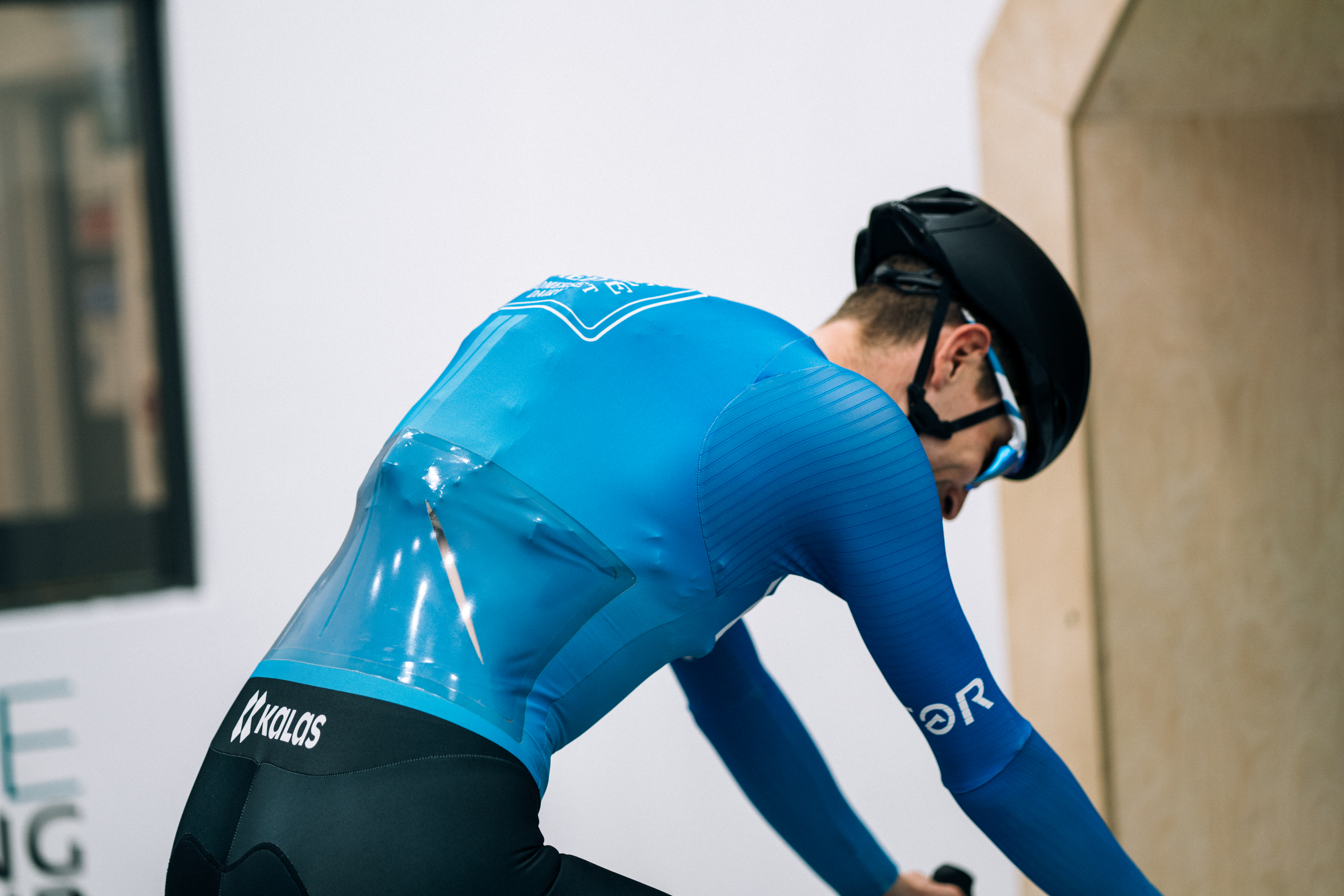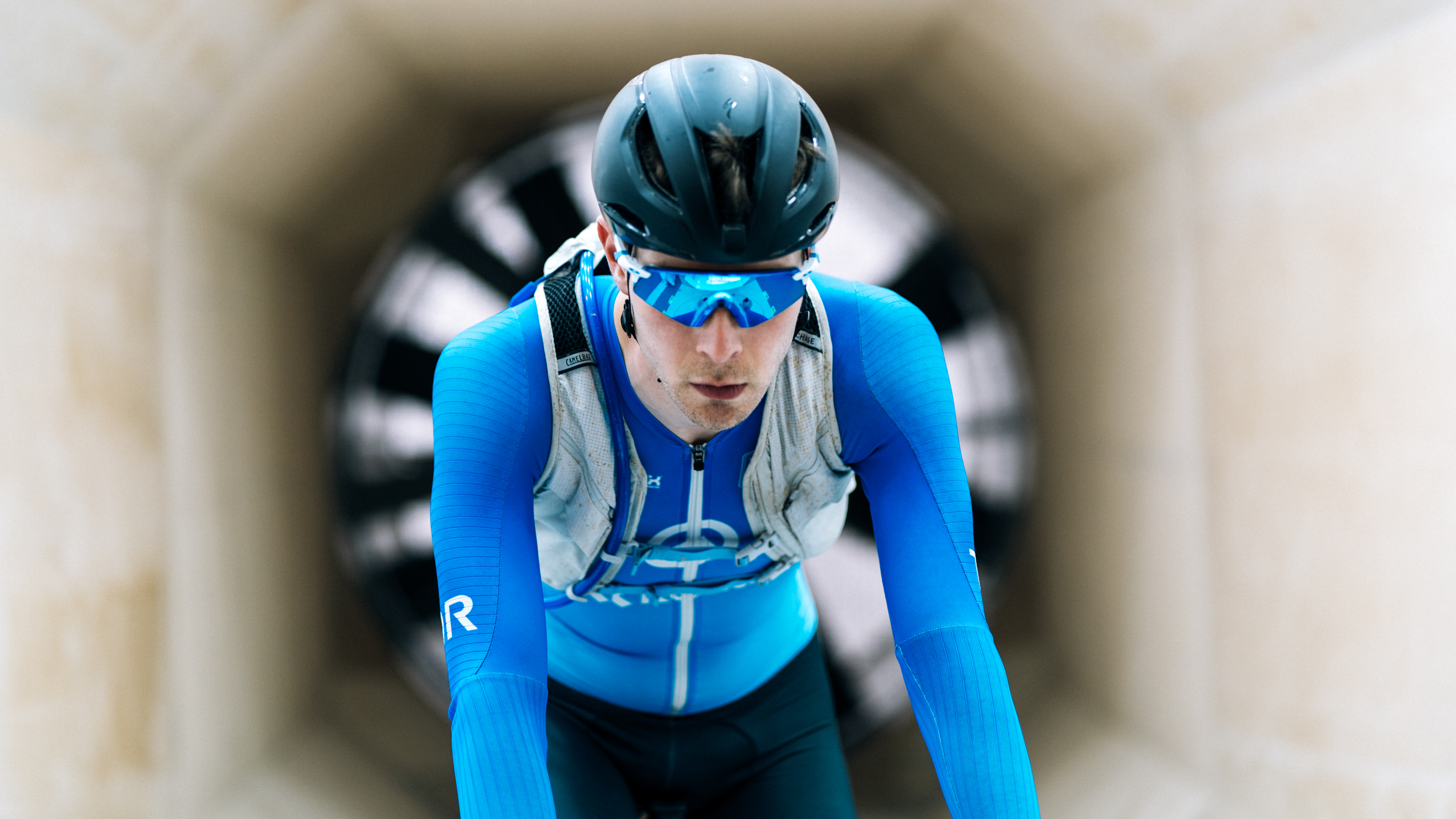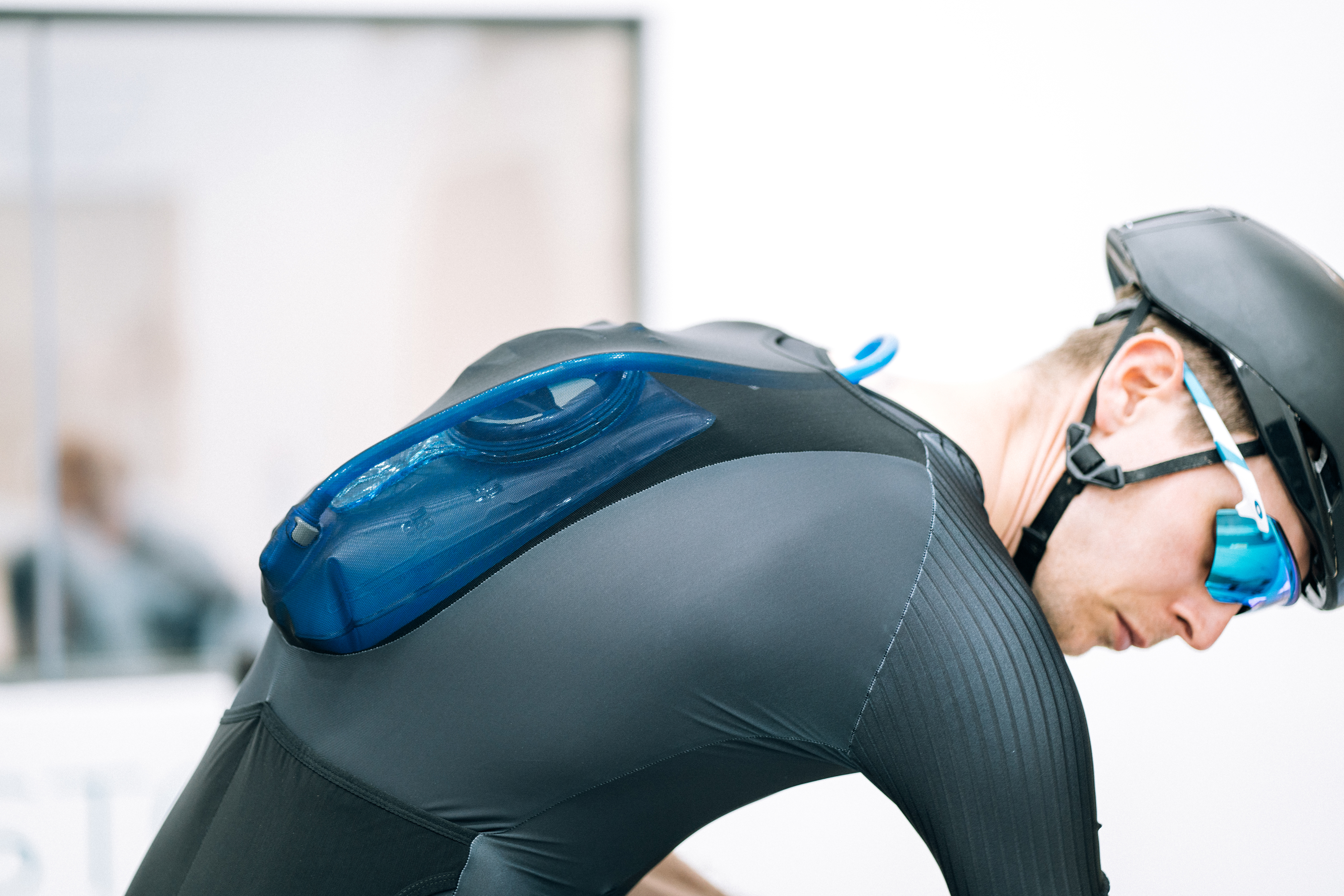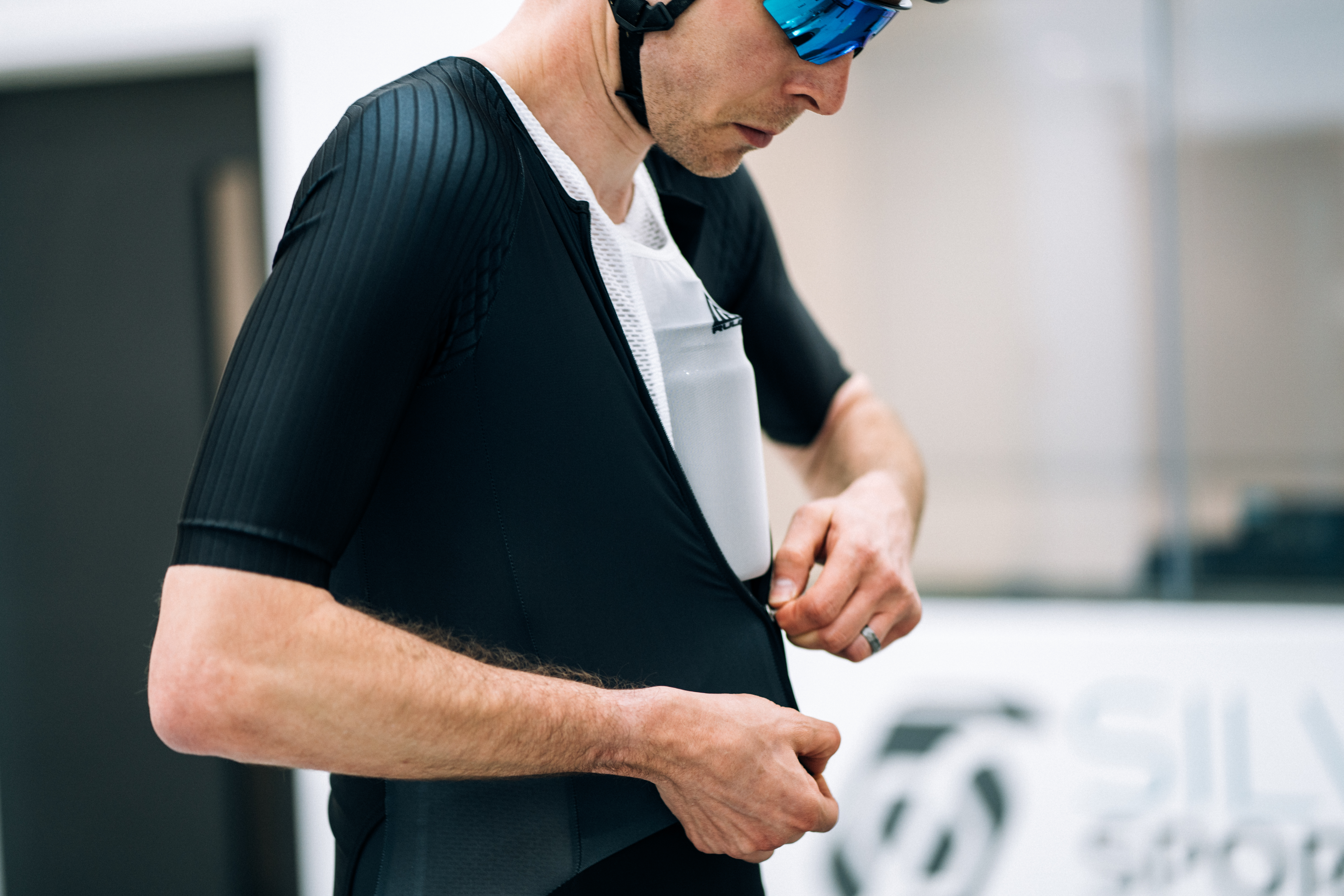Lab tested: Gravel racers, these free hacks could save you over two minutes at Unbound
We've been back in the wind tunnel, this time playing with hydration packs and clever base layers to help you find speed for free

Last week, I wrote a story breaking down the aerodynamic implications of the various available configurations of carrying water bottles on your bike. The story was primarily aimed at road racing cyclists, with the tested configurations covering one, two or three bottles, aero bottles, and a mixture of where you could put them on most bikes.
But with Unbound Gravel set to light up our social media feeds over the coming week, we also wanted to run some tests on carrying a hydration pack to see whether there were any gains to be found.
In last year's race, as Lachlan Morton stormed to Unbound 200 Men's victory, he was wearing an adapted Rapha skinsuit that housed the hydration bladder on the inside. British aero clothing brand Rule 28 has also produced a similar product - its Gravel Suit - which has a sleeve across the back to house a bladder. Castelli's Unlimited jersey offers a similar solution in jersey form too.
Interestingly, USWE, the Swedish brand that makes a host of race-focussed hydration packs, claims that its Race 2.0 pack actually makes you more aerodynamic than not wearing one at all.
All that sounded like some testing was needed, and with an hour of wind tunnel time spare during our recent testing day, we put some ideas to the test.
Here are the questions we wanted to answer:
- Are you more aerodynamic with a hydration pack?
- How does Rule 28's Gravel Suit compare to a normal skinsuit without a hydration pack?
- How does it compare with the hydration pack?
- My cheap version of Lachlan's trick (which I used at Gravel Nationals last year and this year's Gralloch): Does wearing a hydration pack beneath your skinsuit make you faster?
- And finally, how much can you save by stuffing a bottle down your jersey? (For this, we used Rule 28's Cargo base layer to hold it in position!)
And importantly, by way of a prelude, none of this article is sponsored or funded by any of the brands tested. We simply asked Rule 28 and Kalas to borrow their kit, and the Camelbak hydration pack used for testing is my own.
The latest race content, interviews, features, reviews and expert buying guides, direct to your inbox!
The test protocols
To find out, we headed the wind tunnel at Silverstone Sports Engineering Hub, the facilitator of most of the Cyclingnews Labs group tests, including our test of 11 WorldTour level superbikes, 18 high end road wheels, and two-dozen aero helmets.
For each test, the wind speed was set at 40km/h (24.85mph) and the wheels set to spin at a matching speed. The rider on the bike was me (Josh 👋), and my cadence was held at a constant 90rpm.
We were testing to find the CdA (Coefficient of Drag x Area), and this was captured at five different yaw angles: -10, -5, 0, +5 and +10 degrees. This is the angle at which the wind hits the rider, and although we could have stopped at zero – a direct headwind – since most people are largely symmetrical, we opted to test both sides to be more confident in the data we were seeing.
Each capture – the period of time during which CdA readings are measured by the wind tunnel software – was held for 30 seconds, and the resulting reading is given as an average over that 30-second period. Engineers from SSEH keep an eye on the live CdA reading to spot any unexpected fluctuations (most often a result of the rider shifting position suddenly) and if any were spotted, we'd repeat the test. Luckily there were none.
Using the CdA figures, we can then calculate the power it would take to pedal at a given speed.
When doing this, I have weighted the CdA as set out in the research by Barry, 2018. This essentially increases the importance of the lower yaw angles in line with the frequency distribution found in the real world. You spend more time at 0° and 5° yaw than you do at 10° or more, so it's widely accepted as fair to weight accordingly.
Using the weighted average, I have then calculated using the following equation, where Air Density is set at 1.2 kg/m3 and Velocity is 11.1111 m/s (40km/h).
Power (watts) = 0.5 x AirDensity x CdA x Velocity^3
The standardisations
For every test, we kept everything the same apart from the single item of clothing being tested. That extends to the bike; we used a Cube Nuroad C62 SLT that was already in the wind tunnel for our earlier test on road tyre widths. It also extends to the testing protocols, the rider, helmet worn, shoes worn, hand position on the handlebars, pedalling cadence and more.
The wind tunnel was tared prior to each test too, which is essentially the same as zeroing your kitchen scales.
The caveats
As ever, Cyclingnews doesn't claim that this is the final word on the aerodynamic performance of the items tested. Particularly with clothing, each item will undoubtedly perform differently depending on who is wearing it. However, as a means to share the potential available savings between two items or two setups in a controlled test, we think the results are valuable, and interesting if nothing else.
Our stastical error margin for these tests is +/- 2.55 watts (at 40km/h), or a CdA of +/-0.0032 M2. This was calculated using the blue Kalas 'Team Tor' Sonic Suit (my old team kit) at the beginning and end of the day, as part of a wider test around how many watts you can save by investing in your clothing. That test found as many watts as a $14k superbike for 3% of the price.
The results

Are you more aerodynamic with a hydration pack?
There's a simple answer here, and it is… no. At least not with this one!
Without the hydration pack, our CdA data equates to a required power of 322.58 watts. That figure rises by almost seven watts when you add the pack.
Inputting that same CdA and extrapolating over a 200-mile Unbound course, the hydration pack would be setting me back 3 minutes and 43 seconds.
Even when you take into account our error margin, the difference is at the very least 1.6 watts, but potentially as many as 12.15 watts.
If it were me, I'd probably still be wearing one so I could carry the extra fluid, but given the available savings on the table, I'd certainly be looking at how long it'd take me to fill bottles at aid stations to see if I could do that with a net time saving.

Can you offset those losses by wearing it beneath your skinsuit make you faster?
Assuming you've decided you can't do without a hydration pack, then you can mitigate your losses a little bit with my lo-fi hack of simply wearing it inside your skinsuit.
Of course, if you're actually doing Unbound and your fuelling strategy means you're going to need to swap or refill your hydration pack mid race, you'll probably spend longer freeing it from its sweaty prison than you're likely to save on the road, but if you're planning to get round on one hydration pack, refilling bottles instead, then there are savings to be had.
For the sheer fun of doing the maths, when extrapolating it out to the 200 mile course and assuming an average output of 250 watts, it's a potential saving of 57 seconds. Not much, I'll admit, but not bad for free.
If you're doing a shorter race like the Traka 100 or the Gralloch, where two litres of fluid will see you through the entire race, this is a no brainer in my opinion. The differences here are smaller than above, to the point that they're within our error margin, but with as many as four watts on the table at 40km/h, it's enough to consider.
My extra tip for anyone wearing a hydration pack on a warm day is to underfill it with water (ensuring you don't reduce your carbohydrate mix), refrigerate it overnight, then dump a load of ice into the pack before the race. This will help to keep your core temperate down during the first part of the race, potentially giving you a few extra free watts.

How does Rule 28's Gravel Suit fare in comparison?
British brand Rule 28 makes a gravel-specific skinsuit with a sleeve across the back for a hydration pack bladder. This reduces the bulk of carrying the pack itself, and since there aren't any straps across your shoulders, looks like it'll help smoothe airflow across your leading edge more effectively.
For this part of the test, we tested it first without the hydration bladder fitted, then again with it in place. This allowed us to compare how the skinsuit itself compares to our baseline Kalas suit, how they both compare with the respective hydration solutions fitted, and how aerodynamics are affected with the bladder in the rear sleeve.
Again, the differences are within our error margin, but the baseline skinsuit without a hydration pack came out fastest of the lot, with a power requirement of 322.58 watts.
The Rule 28 suit without a hydration pack is the next fastest at 325.53 watts. That's a 2.95-watt penalty, although with our error margin accounted for, that could flip the other way.
The slowest solution of all was the hydration pack worn over the Kalas skinsuit. This is quite understandable, given it leaves the shoulder straps on show to catch the wind.
Most interestingly, while adding a hydration pack costs in the region of 7 watts with the Sonic suit, or 5 watts if you follow my lo-fi hack, adding the bladder to the Rule 28 suit comes at a penalty of just 2.03 watts. This presumably is a result of the hose being draped over the rider's shoulder and into the wind.

Finally: Free watts simply by stuffing a bottle down the front of your jersey?
For this, as mentioned above, we used Rule 28's Cargo base layer to hold the bottle securely, but the same can be achieved without. For clarity, to help readers understand the size of the bottle, I used an Elite Fly lightweight bottle, the 550ml one rather than the larger 750ml option.
Again, the savings are small enough to be within our error margin, but simply stuffing a bottle down the front of my jersey resulted in a saving of 2.73 watts at 40km/h. Accounting our error margin that saving could grow to as much as 7.99 watts, but it's important to consider it could also flip the other way to become a net loss of 2.54 watts.
That wattage saving reduces to a more modest 1.15 watts at more gravel appropriate speeds of 30km/h, but over a long course like Unbound 200, those small savings add up.
Extrapolating that out to the Unbound course and assuming an average power of 250 watts, that's a saving of 1 minute 29 seconds, and perhaps even higher.
However, a very big caveat to say it's important to consider real world application of doing this. Firstly, it's ridiculously uncomfortable. After this test showed a potential saving, I tried it on a long training ride and quickly wrote it off as a raceday option due to the plastic digging into my chest.
Secondly, if you can get over the discomfort, I wouldn't recommend using anything as solid as the bottle I used, and it's especially important not to put anything sharp inside. I wouldn't want to crash with that hard plastic cap pressing against my sternum, nor with a multitool stored inside.
Instead, I'd choose to stuff something like a rain jacket or gloves in the same position for a softer, more comfortable aero hack.
Conclusions
If we add together the two 'free' tricks that don't directly affect your raceday nutrition strategy; wearing your hydration pack inside your skinsuit and stuffing something down the front of your jersey, there's just shy of two and a half minutes on the table here – 2:26 – for absolutely no cost.
Admittedly, the differences are small, but the available time savings shown here are evidence of the importance of aerodymamics at all speeds, not only at WorldTour level, especially in an event as long as Unbound.
Subscribe to Cyclingnews for unlimited access to our coverage of Unbound 2025. Don't miss any of the breaking news, reports, analysis and more from the biggest gravel race of the season, reported by our journalists on the ground in Kansas. Find out more.

Josh is Associate Editor of Cyclingnews – leading our content on the best bikes, kit and the latest breaking tech stories from the pro peloton. He has been with us since the summer of 2019 and throughout that time he's covered everything from buyer's guides and deals to the latest tech news and reviews.
On the bike, Josh has been riding and racing for over 15 years. He started out racing cross country in his teens back when 26-inch wheels and triple chainsets were still mainstream, but he found favour in road racing in his early 20s, racing at a local and national level for Somerset-based Team Tor 2000. These days he rides indoors for convenience and fitness, and outdoors for fun on road, gravel, 'cross and cross-country bikes, the latter usually with his two dogs in tow.
You must confirm your public display name before commenting
Please logout and then login again, you will then be prompted to enter your display name.
